Clematis Ashva - description, planting and care
Perennial clematis Ashva was bred by Lithuanian breeder Leonardas Bakevičius in the 90s. The plant was first marketed in 1998. In 2004, the variety received a bronze medal at the Plantarium exhibition in Holland. Consider its features, planting and care rules.
- Description of the variety
- Landing rules
- Organization of the place
- Preparation of planting material
- Landing technique
- Care features
- Watering
- Loosening and mulching
- Top dressing
- Pruning and garter
- Preparing for winter
- Reproduction methods
- Cuttings
- Stem layering
- By dividing the root
- Diseases and pests
- Rust
- Gray rot
- Powdery mildew
- Wilt (wilting)
- Gall nematode
- Aphids, spider mites and caterpillars
- Snails and slugs
- Application in landscape
- Testimonials
- Useful videos
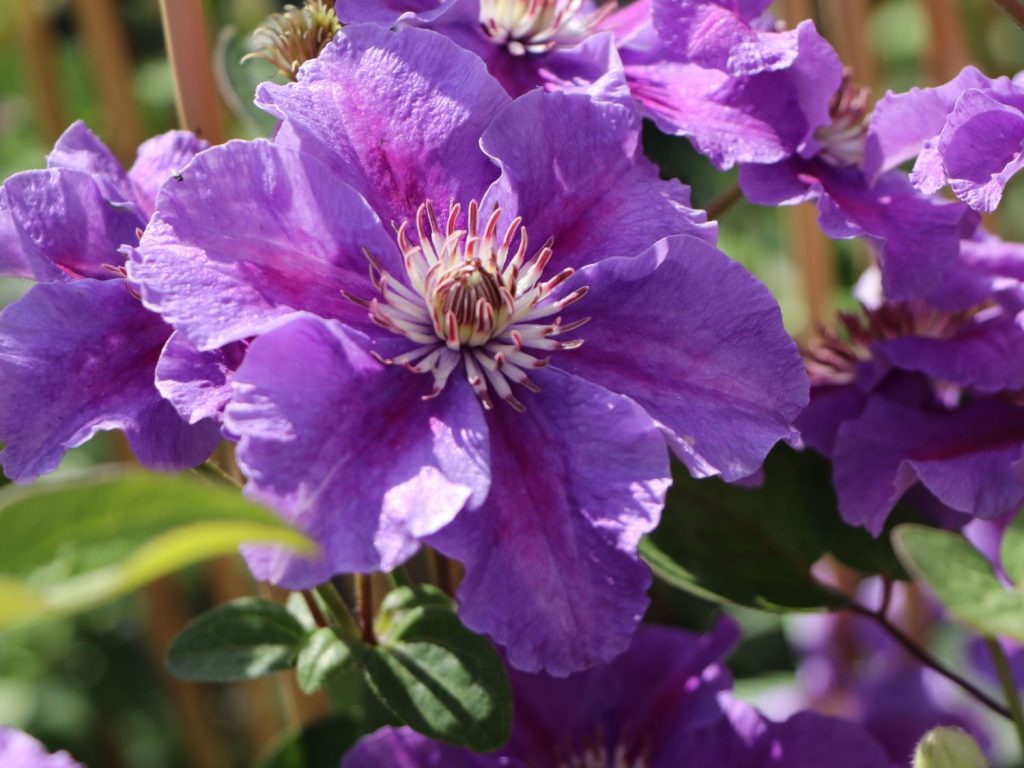
Clematis ashwa description
Description of the variety
The botanical name of the variety is clematis ashva. Opinions on the classification of the plant differ - some attribute it to the Jacquemann group, others to Patens.
The main characteristics of the large-flowered perennial vine:
- height no more than 2 m;
- stems are tough, dark brown, densely leafy;
- leaves are oval or rounded with a pointed tip, emerald, with a smooth surface;
- flowers are large, 8-9 cm in diameter, consist of purple-violet petals, decorated with a crimson stripe in the center.
The buds bloom on the branches of the current year at different times, depending on the region:
- in the middle lane - from June to the first decade of September;
- in the south - from late May to early October.
The root system is able to withstand short-term temperature drops down to -30 ° C. The Ashva variety has good resistance to diseases and pests, provided that all agricultural rules are followed.
Landing rules
The successful cultivation of this variety depends on the correct location, soil and the quality of the planting material.
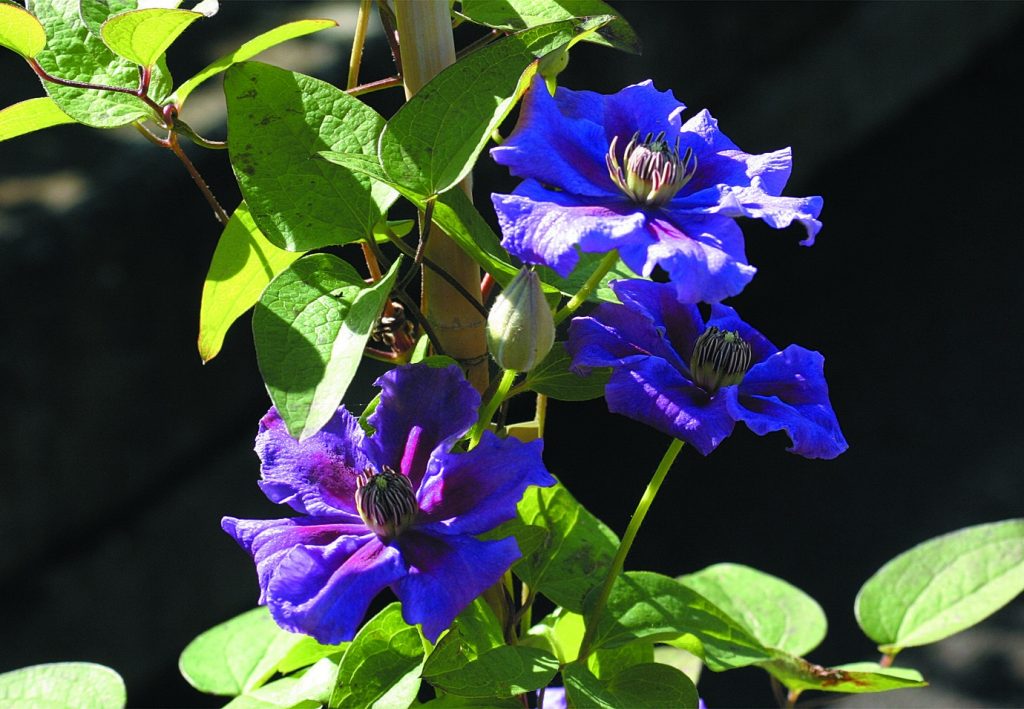
Clematis ashwa trimming group
The best time to plant is spring. The main thing is that the soil warms up to a temperature of 10-12 ° C and the last frosts pass.
In the south, where autumn is warm, liana is planted not only in spring, but also in autumn - until the first half of September. During this time, the seedlings will have time to take root and prepare for the upcoming wintering.
Organization of the place
A place with a deep passage of groundwater, up to 4 m, is suitable for growing this culture. The site should be calm with good access to light in the morning and evening hours.
Clematis will not grow and bloom well if planted in the shade, leaves and flowers turn pale. May cause burns if kept in the sun.
The soil is suitable for light, loose, high nutrient content and low acidity. If the soil is acidified, it is necessary to add dolomite flour, slaked lime or calcite - 350 g per 1 m².
The plot is prepared a month before disembarkation - garden debris, plant residues are removed, dug up and leveled.
Clematis grows well on loamy soil. To improve the structure, add a couple of buckets of sand or vermiculite. If cultivation is planned on sandy loam, add 20 kg of clay.
Preparation of planting material
Clematis Ashva seedlings are sold in a specialized nursery or gardening store.
Bushes with a well-developed crown are considered the best planting material. They should have several densely leafy stems. Such plants have a strong rhizome. The shoots are flexible, without cracks or breaks. Leaves and buds are juicy, saturated green color without yellowness, black spots.
Usually, clematis are sold in containers or with an earthen ball so that the root system is protected from drying out.
Before planting, the seedlings are removed from the container, the roots are soaked in cold water for two hours. Then they are trimmed to 2-3 cm in length to stimulate the development of new processes.
Landing technique
Pits are dug out a couple of weeks before planting seedlings. Their approximate depth and width is 60x70 cm. For a good outflow of moisture, drainage from pebbles, expanded clay and screenings is poured to the bottom. Then a mound is formed from a fertile composition - the dug soil is mixed with compost (last year's manure) and wood ash in a ratio of 1: 1: 0.5.

Clematis ashwa group
To prevent the roots from getting burned, the nutrient mixture is sprinkled with a thin layer of ordinary earth. The roots are lowered, straightened, sprinkled with soil to the top so that voids do not form. Tamped, watered, mulched with peat or humus.
When planting, it is important not to deepen the root collar, otherwise it will quickly rot and the plant will die. When growing in groups, it is necessary to observe the distance between seedlings - at least 1 m.
Care features
Watering
In the first two weeks, the seedling is watered every day - pour 5 liters of water. Moisture will help the roots take root faster and stimulate the growth of the aerial part.
After this time, moistening is carried out as the soil dries to a depth of 4-5 cm.For an adult liana, the irrigation scheme is as follows:
- at the beginning of the growing season;
- two weeks before flowering;
- after its completion;
- in the fall, when the shrub leaves the foliage.
Use settled water at room temperature.
Additionally, the crown is irrigated in the evening hours. Sprinkling stimulates the growth and development of young twigs, leaves, and also prevents the appearance of spider mites.
Loosening and mulching
After each watering, surface loosening of the soil is carried out so that it retains moisture and breathable qualities. Weeds are removed regularly, weeded between rows.
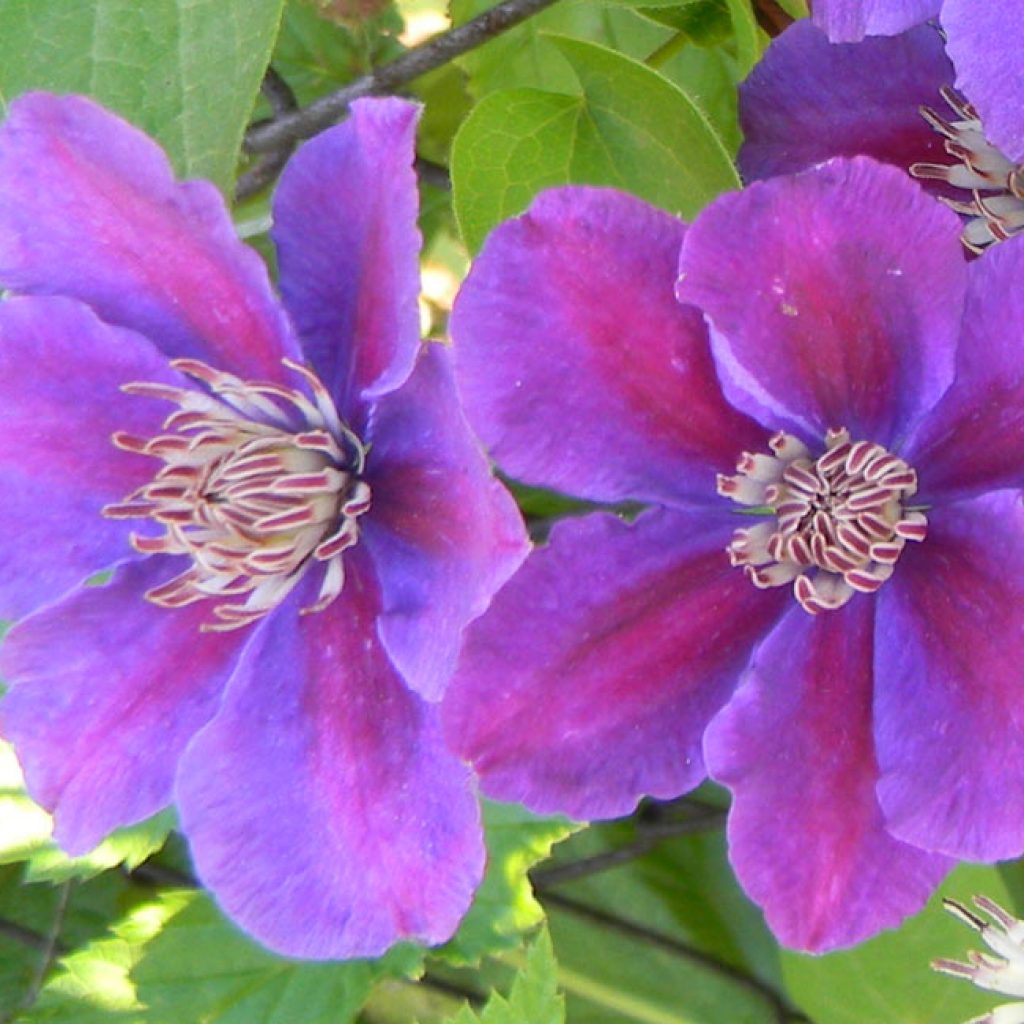
Pruning clematis ashwa
Then they add mulch from peat or last year's manure. It protects the soil from drying out and prevents the growth of unnecessary vegetation in the garden.
Top dressing
The first fertilizer is applied in the third year of life, when all the nutrients laid down during the planting of seedlings are exhausted.
To ensure full growth, bright and lush flowering, clematis ashva is fertilized up to four times per season:
- In early spring, before the leaves bloom, they are fed with nitrogen preparations, which stimulate the growth of greenery. A solution is made from slurry (1 l), ammonium nitrate or nitroammofoska (15 g) in a bucket of water.
- Additionally, potassium nitrate is introduced in mid-April and potassium sulfate at the end of summer at the rate of 25 g per 10 liters of water.
- In the first half of September, bone meal, a source of phosphorus, is embedded in the near-trunk zone. For 1 m², 200 g of the substance is required.
After each feeding, abundant watering is carried out so that the roots quickly absorb the nutrients and do not get burned.
Pruning and garter
Hybrid Clematis Ashva does not need shaping. But if you want to give the vines a compact look, you need to do this in the spring. Cut off branches that thicken the crown or grow in the wrong direction.
Throughout the growing season, it is necessary to cut out shoots and leaves that have lost their decorative effect - they turned yellow, dried out, rotted or were damaged by parasites, diseases.
To protect against infection, a disinfected tool is used, and after pruning, the crown is irrigated with a fungicide.
As the large-flowered liana grows, it needs a garter, without it the shrub will become shapeless, and the twigs will droop.For convenience, clematis is planted near arches, fences, or a trellis or other support is installed along which the stems will curl.
Preparing for winter
Clematis is able to withstand severe frosts, provided that they are short-lived. Without shelter, he can die, especially at an early age.
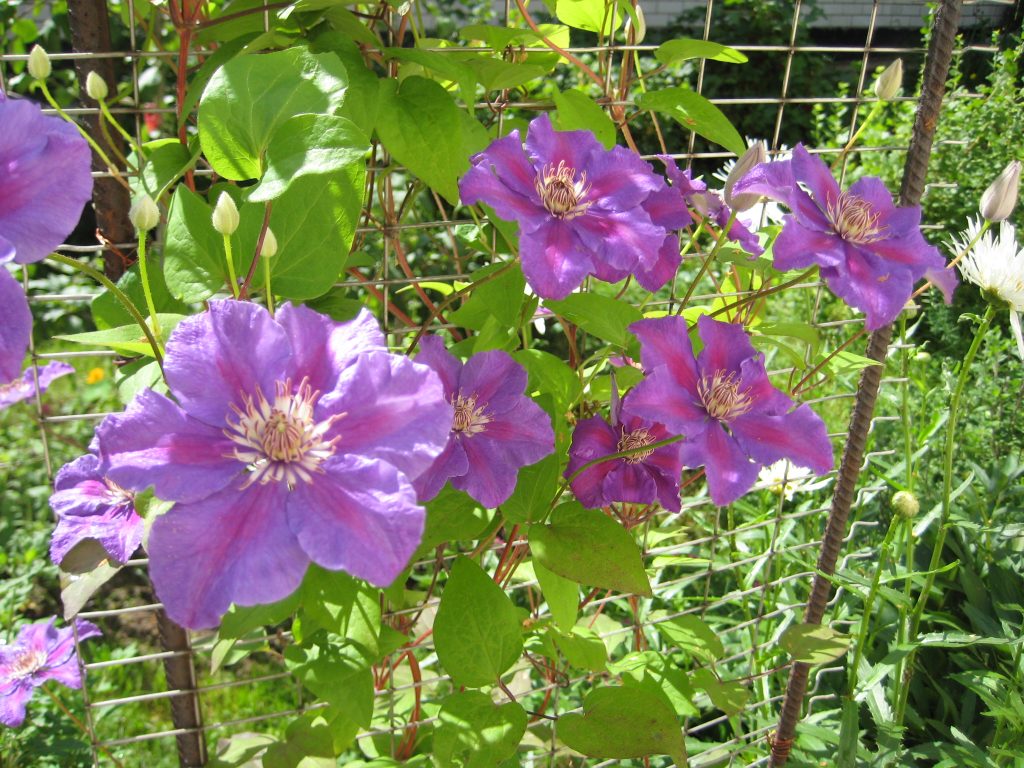
Clematis ashwa pruning
Plants are prepared for winter on the eve of autumn frosts. All diseased parts are cut out, strong shoots are tied into a bundle, bent to the ground. Sprinkle with fallen leaves on top, then lay spruce branches.
The trunk circle is mulched with peat or compost.
The insulation is removed in the spring, when the last frosts have passed and the temperature stabilizes at around 5-7 ° C.
Reproduction methods
Cuttings
Shoots of the current year with several leaves and buds are suitable. They are cut in spring or summer. The optimal length of the cuttings is 12-15 cm. In the lower part, all the leaves are cut off, then they are dipped for an hour in Kornevin's solution to speed up the rooting process.
Cuttings are planted in a mixture of humus, sand and peat, mixed in equal amounts. The planting depth is 3-4 cm. The plantings are watered, covered with a transparent film, placed in a warm and well-lit place.
The seedlings are aired for half an hour every day, moistened with warm water as the substrate dries. As soon as new leaves appear on them, the shelter is removed. After a month of growing at home, they are transplanted into open ground.
Stem layering
For such reproduction, you will need an adult bush from the age of 5 years. On it, the most flexible branch is chosen, which is located close to the ground, and all the leaves are cut off.

Clematis ashwa group
A trench 5-6 cm deep is dug next to it. The bottom is sprinkled with a mixture of peat and sand. The shoot is laid in a horizontal position, fixed with staples, sprinkled with the remaining soil mixture, watered.
To prevent the layers from freezing in winter, a week before the stable cold weather it is insulated with sawdust or fallen leaves, spruce branches are placed on top.
In the spring, when the snow melts, the last frosts will pass, the twig is dug up, cut off from the mother bush. Divided into several parts with roots, planted in the same way as purchased seedlings.
By dividing the root
Usually this method is used for shrubs that have stopped growing, do not bloom well, and need rejuvenation.
The near-stem zone is watered abundantly, then the rhizome is carefully dug out, washed under running water to wash off the remnants of the soil. Dried, cut into pieces with a garden shovel or secateurs. Each delenka should have roots, a stem with leaves and buds.
To avoid infection, the cut sites are irrigated with copper sulfate, sprinkled with crushed coal. They are seated separately in the open field.
Diseases and pests
Clematis is highly resistant to diseases and harmful insects. But if the rules of care and cultivation are violated, the plant becomes weak and begins to hurt.
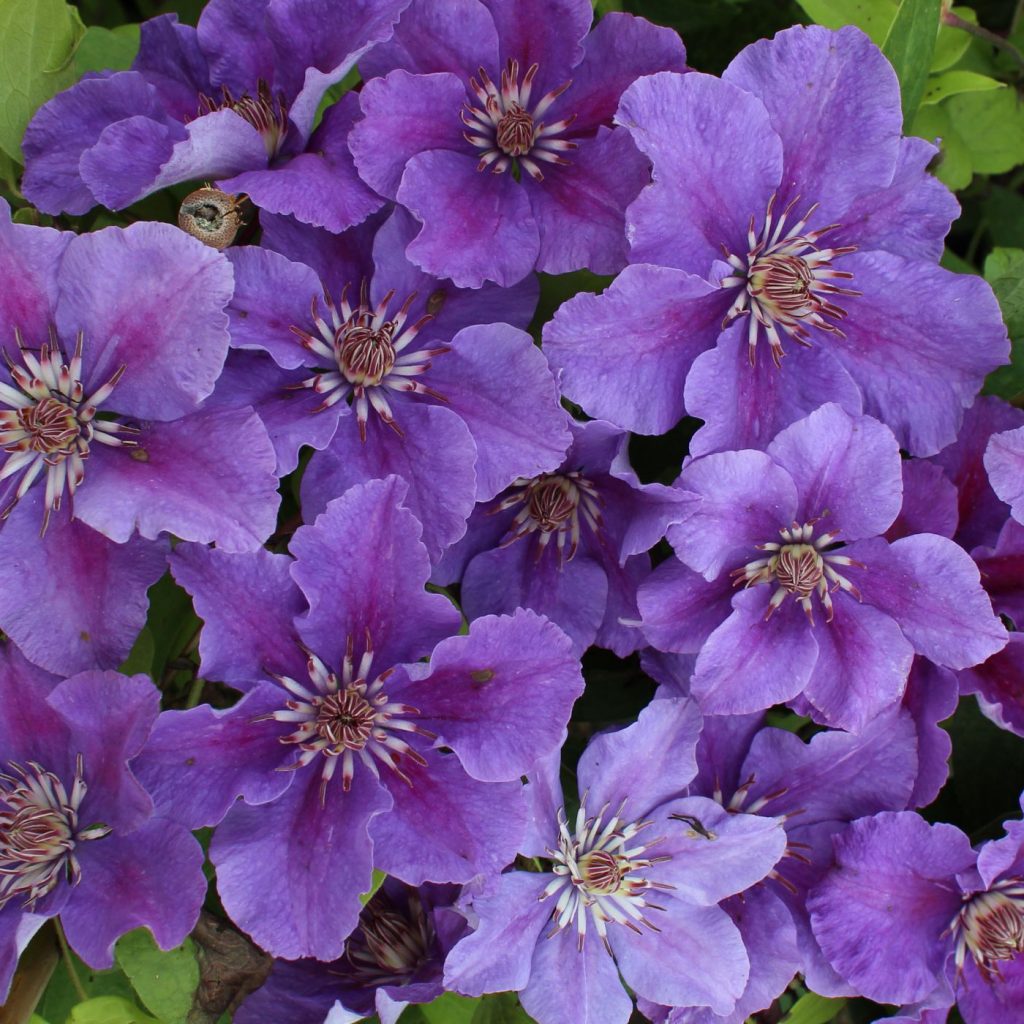
Clematis ashva variety description
Rust
On shoots and leaves, brown or red shapeless growths appear. Places affected by the fungus begin to turn yellow, dry out and die off.
Treatment is carried out in two stages: first, all diseased parts are cut off, then the crown is irrigated with Bordeaux liquid, Topaz or Ridomil gold.
Gray rot
This fungal infection occurs in wet and rainy weather. Signs - the formation of brown spots with a fluffy grayish bloom on the surface of the leaves. The affected parts die off, clematis stops growing, does not bloom.
Control measures: cut out infected leaves, then irrigate the crown with Gamair or 2% Azocene solution.
Powdery mildew
You can identify this sore by a whitish bloom on the surface of leaves, shoots, buds. Over time, the places affected by the fungus darken and die off.
You can cure a shrub with Bactofit, Fitosporin or Pure Blossom.
Wilt (wilting)
Another fungal infection that enters the plant through wounds, cracks, cuts. During propagation by dividing the root and pruning, you need to use a sterile tool, and treat the cut points with a fungicide.
Stems and foliage rapidly wither, darken, clematis dies in a short time.
It is impossible to cure the started stage, so the bush is dug up and disposed of. The well is spilled with a strong solution of potassium permanganate or copper sulfate.
At the initial stage, the vine can still be saved. Crohn is treated with Trichodermine or Glyocladin. An emulsion of 200 g of crushed laundry soap is also effective, mixed with 20 g of copper sulfate, dissolved in 10 liters of water.
Gall nematode
This pest parasitizes in the roots of clematis, so it is difficult to detect it. Often, growers buy an already infected shrub.
With severe damage, the stems become brittle, the leaves become smaller, the buds turn pale or do not tie at all. When the roots die off, the plant dies.
You can destroy this insect with the help of Nemagon, Carbation or other nematicides.
Aphids, spider mites and caterpillars
They feed on the sap of the leaves, which leads to their curling, yellowing and drying out. In the fight against the parasite, insecticides are used - Actellik, Aktaru or Fitoverm.
Snails and slugs
They gnaw out passages in the leaves, leaving a silvery bloom. Pests are collected by hand. To prevent their invasion, the site is sprinkled with wood ash, lime or pine sawdust.
Application in landscape
Large-flowered clematis has become widespread in modern garden design. It is used in several compositions:
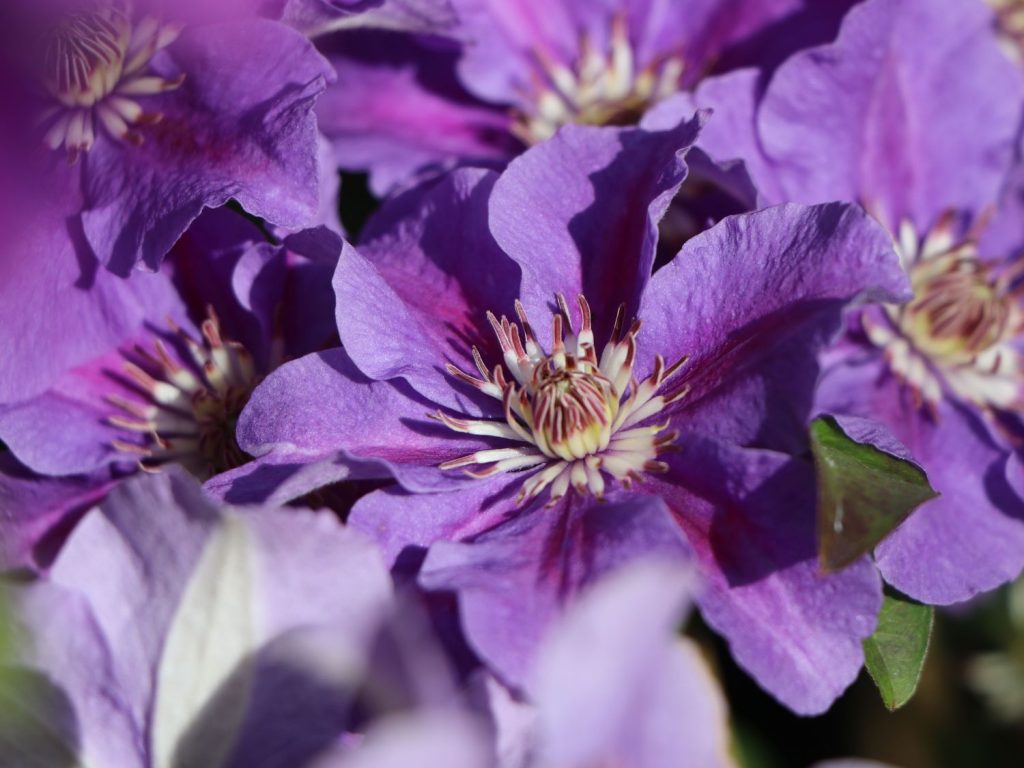
Clematis ashva
- planted singly near arches, gazebos, fences, terraces;
- combined with other types of flowering and decorative deciduous lianas;
- in dachas they are used to decorate the facades of houses, trellises, pergolas;
- perennial shrub is an excellent decor for vertical surfaces and structures - pillars, dead tree trunks.
Testimonials
This plant is in great demand among gardeners and has received many positive reviews:
- grows well on all types of soil, so you can plant it on any site;
- does not need shaping, which greatly facilitates its care;
- decorative liana safely transfers the neighborhood of other vegetation, so it can be used in different compositions.

